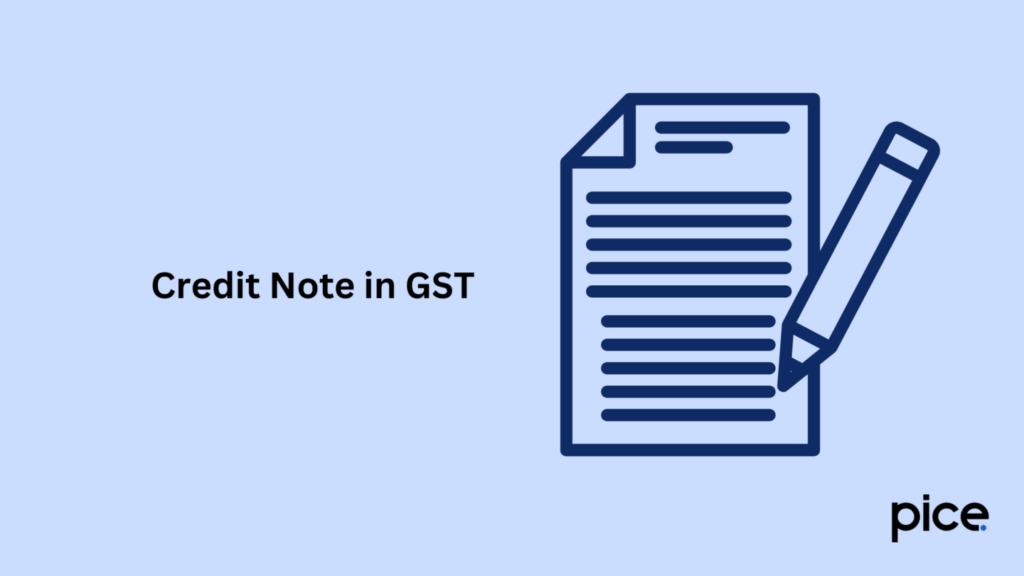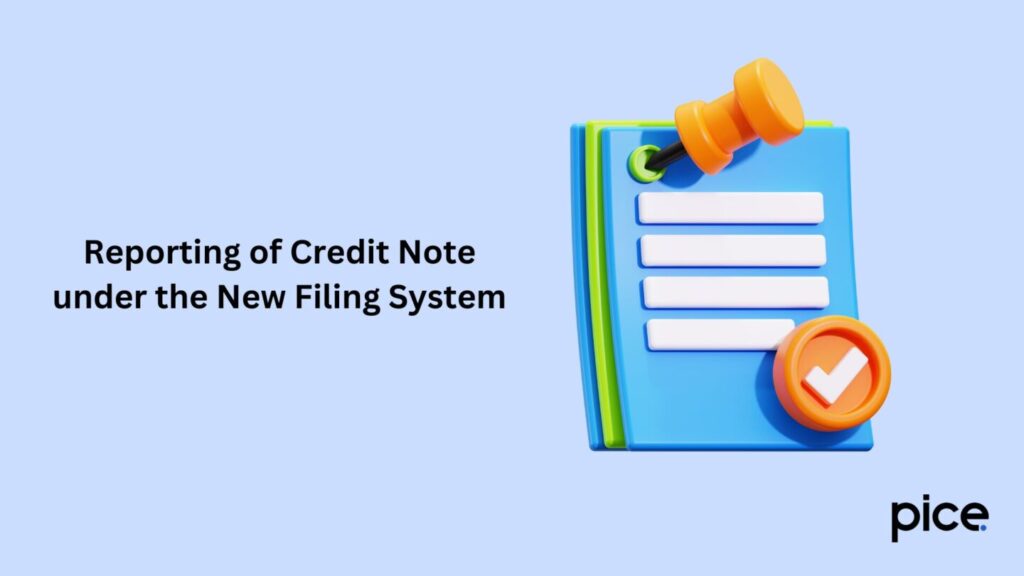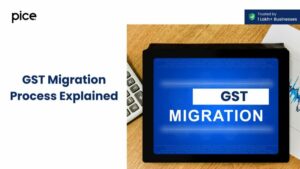How to Issue a Credit Note in GSTR 1?
- 20 Sep 24
- 13 mins

How to Issue a Credit Note in GSTR 1?
Key takeaways
- Credit Notes reduce taxable value and GST liability due to returns, discounts, or errors.
- They must be linked to the original invoice and reported in the correct period.
- The new GST system enables real-time tracking and reduces mismatches.
- Credit Notes impact both the supplier's liability and recipient's Input Tax Credit (ITC).
- Accurate reporting ensures compliance and prevents tax discrepancies.
A Credit Note is a document issued by a seller to a buyer, indicating a reduction in the amount that the buyer owes to the seller. It is usually issued when goods are returned, or there is a downward revision in the value of the invoice. Credit Notes are essential in the GST framework as they allow for adjustments in the taxable value or tax charged on a previously issued invoice.
This blog outlines the importance of Credit Notes in GST, how they are reported under both the existing and new filing systems, and the changes brought by the new GST returns, helping businesses stay updated and compliant with the latest regulations.
Credit Note in GST

A Credit Note under GST is a document issued by a supplier when the taxable value or tax charged in the original tax invoice is higher than the actual amount payable. This could be due to various reasons such as incorrect value, wrong rate of tax, or returning of goods by the recipient. The Credit Note serves as a correction to the original invoice, reducing the supplier's tax liability for that transaction.
Issue of Credit Note in Case of Expiry of Goods
In cases where goods expire before being sold or are returned due to expiry, the supplier may issue a Credit Note to adjust the value of the original invoice. This adjustment allows the supplier to reduce their GST liability accordingly.
This process is particularly important for perishable goods or items with a short shelf life, where expiry can lead to returns or write-offs. The supplier can then claim a reduction in the tax liability, reflecting the actual sale that took place.
Format of Credit Note
A Credit Note under the Goods and Services Tax (GST) regime is an essential document issued by a supplier when there is a need to correct or adjust the taxable value or tax charged in the original tax invoice. This adjustment could be due to various reasons, such as goods being returned, discounts being provided after the invoice was issued, or the incorrect application of tax rates.
The issuance and format of a Credit Note are governed by specific provisions under GST law, ensuring that both the supplier and recipient maintain accurate financial records.
Key Components of a Credit Note under GST
A Credit Note issued under GST must comply with the following formatting requirements:
- Supplier's Details:
- Name and Address: The legal name and registered address of the supplier must be clearly mentioned.
- GSTIN: The Goods and Services Tax Identification Number (GSTIN) of the supplier, which is a unique 15-digit code, must be included.
- Serial Number:
- The Credit Note must have a consecutive serial number not exceeding sixteen characters. This serial number can be in one or multiple series but should be unique for each financial year.
- Date of Issue:
- The date of issuance of the Credit Note must be stated. This date is crucial as it determines the time limit for reporting the Credit Note in the GST returns.
- Recipient's Details:
- Name and Address: The legal name and registered address of the recipient must be included.
- GSTIN or UIN: If the recipient is registered, their GSTIN must be mentioned. For unregistered recipients, this can be omitted.
- Original Invoice Reference:
- The Credit Note must reference the original invoice number and date to which it pertains. This helps in linking the Credit Note to the original transaction.
- Details of Taxable Value and Tax:
- The taxable value of the goods or services for which the Credit Note is being issued must be clearly mentioned.
- The rate of tax (CGST, SGST, IGST, or UTGST) applicable to the transaction must be specified.
- The amount of tax that is being credited or debited to the recipient's account should be accurately calculated and mentioned.
- Signature:
- The Credit Note must include the signature or digital signature of the supplier or their authorized representative. This signature validates the document and makes it legally binding.
Importance of Properly Formatting a Credit Note
The correct format of a Credit Note ensures compliance with GST regulations and helps in maintaining accurate records for both the supplier and the recipient. It also facilitates the correct adjustment of tax liability, preventing issues during audits or assessments.
Additionally, a properly issued Credit Note allows the supplier to reduce their output tax liability and the recipient to adjust their Input Tax Credit (ITC) accordingly.
When Should a Credit Note be Issued?
A Credit Note under GST is a critical document for adjusting the taxable value or tax charged in the original invoice. It ensures that businesses can rectify any discrepancies in their billing and tax liabilities, thereby maintaining accurate records. Here are the key scenarios when a Credit Note should be issued:
- Goods Returned by the Buyer:
- If the buyer returns the goods after they have been delivered, a Credit Note should be issued to adjust the taxable value and the GST originally charged. This is a common occurrence in industries where goods might be returned due to overstocking, wrong deliveries, or unsatisfactory product quality.
- Deficiency or Fault in Goods or Services:
- When goods or services are found to be deficient or faulty, the supplier may issue a Credit Note to reduce the taxable value. This situation arises when the quality of the delivered goods or services does not meet the agreed-upon standards or expectations, necessitating a reduction in the price.
- Downward Revision in Price:
- If there is a downward revision in the price of the goods or services after the original invoice is issued, a Credit Note should be issued to reflect the new price. This can occur due to post-sale discounts, promotions, or renegotiated terms with the buyer.
- Error in the Original Invoice:
- If an error is discovered in the original invoice, such as an incorrect tax rate or excess charge, a Credit Note should be issued to correct the mistake. This ensures that both the supplier and the recipient have accurate records of the transaction and that the correct amount of GST is reported and paid.
Difference between Debit Note and Credit Note

A Debit Note is issued by the buyer to the seller when the buyer returns goods or there is a short supply. It signifies an increase in liability. Conversely, a Credit Note is issued by the seller to the buyer, reducing the buyer’s liability towards the seller.
| Aspect | Debit Note | Credit Note |
| Purpose | Increases the buyer’s liability | Decreases the buyer’s liability |
| Issued By | Buyer | Seller |
| Usage | Used when goods are returned or there is a short supply | Used for reducing an invoice’s value, such as for returns or price revisions |
| Impact on Financial Records | Increases amount payable by the buyer, affecting accounts payable and accounts receivable | Decreases amount payable by the buyer, affecting accounts receivable and accounts payable |
| GST Implications | May increase tax liability if the taxable value increases | Reduces tax liability by lowering the taxable value or correcting overcharges |
| Scenario Examples | Goods returned, short supply, invoice amount needs to be increased | Invoice correction, goods returned, post-sale discount |
Impact of New GST Returns on Credit Note Reporting
The introduction of the new GST return filing system has brought several changes to the way businesses report transactions, including Credit Notes. Understanding these changes is crucial for businesses to remain compliant and to ensure accurate tax reporting.
Key Changes in Credit Note Reporting
- Reporting in GSTR-1:
- Under the new GST returns, Credit Notes must be reported in the same month in which they are issued. This aligns with the original invoice reporting, ensuring that the adjustments are reflected in the correct tax period. Failure to report a Credit Note in the correct period can lead to discrepancies and potential penalties.
- Linking with Original Invoice:
- The new system emphasizes linking Credit Notes directly with the original invoices. This requirement ensures that the adjustments made through Credit Notes are accurately tracked and matched against the initial taxable supply. It also helps in avoiding any misreporting or duplication of entries.
- Impact on Input Tax Credit (ITC):
- The new GST returns affect how Input Tax Credit (ITC) is adjusted when a Credit Note is issued. The reduction in the taxable value due to a Credit Note will correspondingly reduce the ITC available to the recipient. It is essential for recipients to monitor these adjustments to ensure their ITC claims are accurate.
- Reconciliation and Compliance:
- The reconciliation process under the new GST returns has become more stringent. Businesses need to reconcile Credit Notes with their returns regularly to ensure that all entries match and that there are no discrepancies between the GSTR-1 (outward supplies) and GSTR-3B (summary return). This reconciliation helps in maintaining compliance and avoiding notices or audits from tax authorities.
- Automatic Calculation of Liability:
- With the new returns, the system automatically calculates the tax liability after adjusting for Credit Notes. This automation reduces manual errors but requires businesses to be vigilant about correctly reporting Credit Notes to avoid any unintended tax liabilities.
Reporting of Credit Note under the Existing Filing System
Under the existing GST filing system, Credit Notes are reported in the monthly return form GSTR-1. The details of the Credit Note, such as the original invoice number, the date of issue, the amount of adjustment, and the tax amount, must be provided in this form.
The Credit Note must be linked to the original invoice to ensure accurate reflection in the buyer's and seller's records. The Credit Note should be reported in the same period in which it is issued, ensuring that the tax liability is adjusted in the correct month.
If the Credit Note is not reported within the correct period, it may lead to mismatches between GSTR-1 and GSTR-3B, resulting in discrepancies during reconciliation.
Reporting of Credit Note under the New Filing System

The new GST return system, which includes forms like ANX-1 and RET-1, introduces more streamlined reporting of Credit Notes. In this system, Credit Notes are to be reported in ANX-1 in the same period they are issued. One key change is that the new system allows for real-time tracking and matching of Credit Notes with the original invoices, reducing the chances of mismatches.
Another important aspect is the enhanced linkage between Credit Notes and the corresponding invoices, ensuring that adjustments are accurately reflected in the tax liabilities and ITC claims of both parties. This new system is designed to simplify the reporting process and minimize errors, but it requires businesses to be more diligent in timely and accurate reporting.
Under the existing filing system, the reporting of Credit Notes involves key details like the GST registration of the registered person and the specifics of the original invoice. When a registered person issues a Credit Note, it must be accurately reported in the GSTR-1 return for the same month or the subsequent month.
This process is crucial for both B2B and B2C supplies, ensuring that the correct tax liability is reflected.
Any additional charge or credit adjustment made must align with the supplementary invoice details and the quality issues reported by customers. Proper adherence to the legal provisions and careful documentation on the GST portal ensures compliance with the common portal's requirements, which ultimately contributes to accurate annual returns and customer satisfaction
Revised Invoice under GST
A Revised Invoice under GST is issued when an original invoice contains errors, such as incorrect details or miscalculations of tax. The Revised Invoice is a corrected version of the original invoice and must include a reference to the original invoice number and date.
Revised Invoices must be issued within the prescribed time limits under GST law, typically before the return for the month in which the goods or services were supplied is filed. The issuance of a Revised Invoice ensures that both the supplier and the recipient have accurate records, and it also allows for the correct reflection of tax liabilities in the returns.
Conclusion
Credit Notes play a critical role in the GST framework, enabling adjustments in tax liabilities and ensuring that the correct amount is paid. With the introduction of the new GST returns, reporting Credit Notes has become more efficient, reducing the scope for errors and mismatches.
Businesses must be diligent in issuing and reporting Credit Notes to maintain compliance with GST regulations.
💡If you want to pay your GST with Credit Card, then download Pice Business Payment App. Pice is the one stop app for paying all your business expenses.
 By
By 


















